+ Open data
Open data
- Basic information
Basic information
| Entry | Database: PDB / ID: 7mko | |||||||||
|---|---|---|---|---|---|---|---|---|---|---|
| Title | Escherichia coli RNA polymerase elongation complex | |||||||||
 Components Components |
| |||||||||
 Keywords Keywords | TRANSCRIPTION/DNA/RNA / RNAP recycling / RapA / Post-Termination Complex / PTC / TRANSCRIPTION / TRANSCRIPTION-DNA-RNA complex | |||||||||
| Function / homology |  Function and homology information Function and homology informationRNA polymerase complex / submerged biofilm formation / cellular response to cell envelope stress / regulation of DNA-templated transcription initiation / bacterial-type flagellum assembly / bacterial-type RNA polymerase core enzyme binding / cytosolic DNA-directed RNA polymerase complex / bacterial-type flagellum-dependent cell motility / nitrate assimilation / regulation of DNA-templated transcription elongation ...RNA polymerase complex / submerged biofilm formation / cellular response to cell envelope stress / regulation of DNA-templated transcription initiation / bacterial-type flagellum assembly / bacterial-type RNA polymerase core enzyme binding / cytosolic DNA-directed RNA polymerase complex / bacterial-type flagellum-dependent cell motility / nitrate assimilation / regulation of DNA-templated transcription elongation / transcription elongation factor complex / transcription antitermination / cell motility / DNA-templated transcription initiation / ribonucleoside binding / DNA-directed RNA polymerase / DNA-directed RNA polymerase activity / response to heat / protein-containing complex assembly / intracellular iron ion homeostasis / protein dimerization activity / DNA-templated transcription / magnesium ion binding / DNA binding / zinc ion binding / cytosol Similarity search - Function | |||||||||
| Biological species |   | |||||||||
| Method | ELECTRON MICROSCOPY / single particle reconstruction / cryo EM / Resolution: 3.15 Å | |||||||||
 Authors Authors | Qayyum, M.Z. / Murakami, K.S. | |||||||||
| Funding support |  United States, 2items United States, 2items
| |||||||||
 Citation Citation |  Journal: J Biol Chem / Year: 2021 Journal: J Biol Chem / Year: 2021Title: Structural basis of RNA polymerase recycling by the Swi2/Snf2 family of ATPase RapA in Escherichia coli. Authors: M Zuhaib Qayyum / Vadim Molodtsov / Andrew Renda / Katsuhiko S Murakami /  Abstract: After transcription termination, cellular RNA polymerases (RNAPs) are occasionally trapped on DNA, impounded in an undefined post-termination complex (PTC), limiting the free RNAP pool and ...After transcription termination, cellular RNA polymerases (RNAPs) are occasionally trapped on DNA, impounded in an undefined post-termination complex (PTC), limiting the free RNAP pool and subsequently leading to inefficient transcription. In Escherichia coli, a Swi2/Snf2 family of ATPase called RapA is known to be involved in countering such inefficiency through RNAP recycling; however, the precise mechanism of this recycling is unclear. To better understand its mechanism, here we determined the structures of two sets of E. coli RapA-RNAP complexes, along with the RNAP core enzyme and the elongation complex, using cryo-EM. These structures revealed the large conformational changes of RNAP and RapA upon their association that has been implicated in the hindrance of PTC formation. Our results along with DNA-binding assays reveal that although RapA binds RNAP away from the DNA-binding main channel, its binding can allosterically close the RNAP clamp, thereby preventing its nonspecific DNA binding and PTC formation. Taken together, we propose that RapA acts as a guardian of RNAP by which RapA prevents nonspecific DNA binding of RNAP without affecting the binding of promoter DNA recognition σ factor, thereby enhancing RNAP recycling. | |||||||||
| History |
|
- Structure visualization
Structure visualization
| Movie |
 Movie viewer Movie viewer |
|---|---|
| Structure viewer | Molecule:  Molmil Molmil Jmol/JSmol Jmol/JSmol |
- Downloads & links
Downloads & links
- Download
Download
| PDBx/mmCIF format |  7mko.cif.gz 7mko.cif.gz | 614.1 KB | Display |  PDBx/mmCIF format PDBx/mmCIF format |
|---|---|---|---|---|
| PDB format |  pdb7mko.ent.gz pdb7mko.ent.gz | 473.4 KB | Display |  PDB format PDB format |
| PDBx/mmJSON format |  7mko.json.gz 7mko.json.gz | Tree view |  PDBx/mmJSON format PDBx/mmJSON format | |
| Others |  Other downloads Other downloads |
-Validation report
| Summary document |  7mko_validation.pdf.gz 7mko_validation.pdf.gz | 1 MB | Display |  wwPDB validaton report wwPDB validaton report |
|---|---|---|---|---|
| Full document |  7mko_full_validation.pdf.gz 7mko_full_validation.pdf.gz | 1.1 MB | Display | |
| Data in XML |  7mko_validation.xml.gz 7mko_validation.xml.gz | 95.9 KB | Display | |
| Data in CIF |  7mko_validation.cif.gz 7mko_validation.cif.gz | 146.3 KB | Display | |
| Arichive directory |  https://data.pdbj.org/pub/pdb/validation_reports/mk/7mko https://data.pdbj.org/pub/pdb/validation_reports/mk/7mko ftp://data.pdbj.org/pub/pdb/validation_reports/mk/7mko ftp://data.pdbj.org/pub/pdb/validation_reports/mk/7mko | HTTPS FTP |
-Related structure data
| Related structure data |  23901MC  7mknC  7mkpC  7mkqC M: map data used to model this data C: citing same article ( |
|---|---|
| Similar structure data |
- Links
Links
- Assembly
Assembly
| Deposited unit | 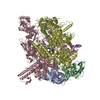
|
|---|---|
| 1 |
|
- Components
Components
-DNA-directed RNA polymerase subunit ... , 4 types, 5 molecules ABCDE
| #1: Protein | Mass: 26213.830 Da / Num. of mol.: 2 Source method: isolated from a genetically manipulated source Source: (gene. exp.)  Strain: K12 / Gene: rpoA, FAZ83_23195 / Production host:  References: UniProt: A0A4S5AL01, DNA-directed RNA polymerase #2: Protein | | Mass: 150590.547 Da / Num. of mol.: 1 Source method: isolated from a genetically manipulated source Source: (gene. exp.)  Strain: K12 / Gene: rpoB, FAZ83_22375 / Production host:  References: UniProt: A0A4S4NK82, DNA-directed RNA polymerase #3: Protein | | Mass: 150865.766 Da / Num. of mol.: 1 Source method: isolated from a genetically manipulated source Source: (gene. exp.)  Strain: K12 / Gene: rpoC, FAZ83_22370 / Production host:  References: UniProt: A0A6D2WUT6, DNA-directed RNA polymerase #4: Protein | | Mass: 10249.547 Da / Num. of mol.: 1 Source method: isolated from a genetically manipulated source Source: (gene. exp.)  Strain: K12 / Gene: rpoZ, b3649, JW3624 / Production host:  |
|---|
-DNA chain , 2 types, 2 molecules NT
| #5: DNA chain | Mass: 8840.689 Da / Num. of mol.: 1 Source method: isolated from a genetically manipulated source Source: (gene. exp.)   |
|---|---|
| #7: DNA chain | Mass: 8813.646 Da / Num. of mol.: 1 Source method: isolated from a genetically manipulated source Source: (gene. exp.)   |
-RNA chain , 1 types, 1 molecules R
| #6: RNA chain | Mass: 3625.242 Da / Num. of mol.: 1 Source method: isolated from a genetically manipulated source Source: (gene. exp.)   |
|---|
-Non-polymers , 3 types, 4 molecules 




| #8: Chemical | ChemComp-MG / | ||
|---|---|---|---|
| #9: Chemical | | #10: Chemical | ChemComp-2TM / | |
-Details
| Has ligand of interest | Y |
|---|
-Experimental details
-Experiment
| Experiment | Method: ELECTRON MICROSCOPY |
|---|---|
| EM experiment | Aggregation state: PARTICLE / 3D reconstruction method: single particle reconstruction |
- Sample preparation
Sample preparation
| Component | Name: Escherichia coli RNA polymerase elongation complex / Type: COMPLEX / Entity ID: #1-#7 / Source: RECOMBINANT |
|---|---|
| Source (natural) | Organism:  |
| Source (recombinant) | Organism:  |
| Buffer solution | pH: 8 |
| Specimen | Embedding applied: NO / Shadowing applied: NO / Staining applied: NO / Vitrification applied: YES |
| Vitrification | Cryogen name: ETHANE |
- Electron microscopy imaging
Electron microscopy imaging
| Experimental equipment |  Model: Titan Krios / Image courtesy: FEI Company |
|---|---|
| Microscopy | Model: FEI TITAN KRIOS |
| Electron gun | Electron source:  FIELD EMISSION GUN / Accelerating voltage: 300 kV / Illumination mode: OTHER FIELD EMISSION GUN / Accelerating voltage: 300 kV / Illumination mode: OTHER |
| Electron lens | Mode: OTHER |
| Image recording | Electron dose: 40 e/Å2 / Detector mode: COUNTING / Film or detector model: GATAN K2 SUMMIT (4k x 4k) |
- Processing
Processing
| Software |
| ||||||||||||||||||||||||
|---|---|---|---|---|---|---|---|---|---|---|---|---|---|---|---|---|---|---|---|---|---|---|---|---|---|
| CTF correction | Type: PHASE FLIPPING AND AMPLITUDE CORRECTION | ||||||||||||||||||||||||
| 3D reconstruction | Resolution: 3.15 Å / Resolution method: FSC 0.143 CUT-OFF / Num. of particles: 256565 / Symmetry type: POINT | ||||||||||||||||||||||||
| Refinement | Cross valid method: NONE Stereochemistry target values: GeoStd + Monomer Library + CDL v1.2 | ||||||||||||||||||||||||
| Displacement parameters | Biso mean: 50.88 Å2 | ||||||||||||||||||||||||
| Refine LS restraints |
|
 Movie
Movie Controller
Controller






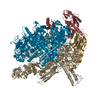
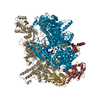
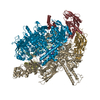
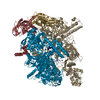
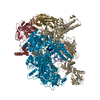
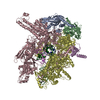


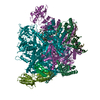
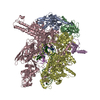
 PDBj
PDBj


































































